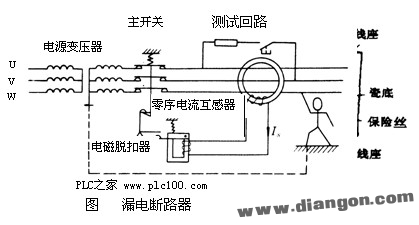(1) Function: A leakage circuit breaker, also known as a residual current device (RCD), is primarily used to quickly disconnect the power supply in case of electric shock or leakage, ensuring personal safety and preventing electrocution. Some models also provide overload and short-circuit protection, making them suitable for starting and stopping motors infrequently.
(2) Working Principle: Under normal operation, regardless of whether the three-phase load is balanced, the sum of the three-phase current phasors passing through the main circuit of the zero-sequence current transformer equals zero. This means no induced electromotive force is generated in the secondary winding, allowing the leakage protector to remain in a closed state. However, during a leakage or electric shock situation, the sum of the three-phase currents becomes unbalanced and reaches a certain value, denoted as Is. This current flows through the human body's neutral point, the earth, and the transformer, inducing an electromotive force in the secondary winding of the zero-sequence current transformer. This voltage is then applied to the trip unit. When Is reaches a predetermined threshold, the trip unit activates, causing the main switch to open and interrupt the circuit.
 (3) Parameters and Types: Key parameters include rated current, rated leakage current, and rated leakage operation time. Leakage protectors can be categorized based on their action mode—voltage or current action type. By mechanism, they can be either switch-type or relay-type. In terms of poles and lines, they come in single-pole two-wire, two-pole, two-pole three-wire, and three-pole four-wire configurations.
(4) Selection Criteria: Choosing the right leakage protector depends on its intended use and operating conditions. For personal protection, high-sensitivity and fast-acting models should be installed at the end of the line. For equipment grounding and protection, medium-sensitivity and fast-acting devices are recommended. To prevent fires caused by leakage, medium-sensitivity and time-delay types are ideal. Regarding power supply modes: use single-pole two-wire or two-pole models for single-phase systems, three-pole for three-phase systems, and three-pole four-wire or four-pole models when both three-phase and single-phase loads are present.
(5) Installation Tips: When selecting the number of poles for the leakage protector, ensure it matches the number of lines in the protected circuit. After installation, check the reliability of the leakage protection system, including the meter and fuse. Regular maintenance and testing are essential to ensure continuous safety and proper functioning.
(3) Parameters and Types: Key parameters include rated current, rated leakage current, and rated leakage operation time. Leakage protectors can be categorized based on their action mode—voltage or current action type. By mechanism, they can be either switch-type or relay-type. In terms of poles and lines, they come in single-pole two-wire, two-pole, two-pole three-wire, and three-pole four-wire configurations.
(4) Selection Criteria: Choosing the right leakage protector depends on its intended use and operating conditions. For personal protection, high-sensitivity and fast-acting models should be installed at the end of the line. For equipment grounding and protection, medium-sensitivity and fast-acting devices are recommended. To prevent fires caused by leakage, medium-sensitivity and time-delay types are ideal. Regarding power supply modes: use single-pole two-wire or two-pole models for single-phase systems, three-pole for three-phase systems, and three-pole four-wire or four-pole models when both three-phase and single-phase loads are present.
(5) Installation Tips: When selecting the number of poles for the leakage protector, ensure it matches the number of lines in the protected circuit. After installation, check the reliability of the leakage protection system, including the meter and fuse. Regular maintenance and testing are essential to ensure continuous safety and proper functioning.
Photovoltaic Carport Structure
Photovoltaic Carport Structure,Solar Carport Mounting Structure System,Carport Mounting Structure System,Solar Energy System Metal Carports
Hebei Shuobiao New Energy Technology Co., Ltd. , https://www.pvbracketsystem.com